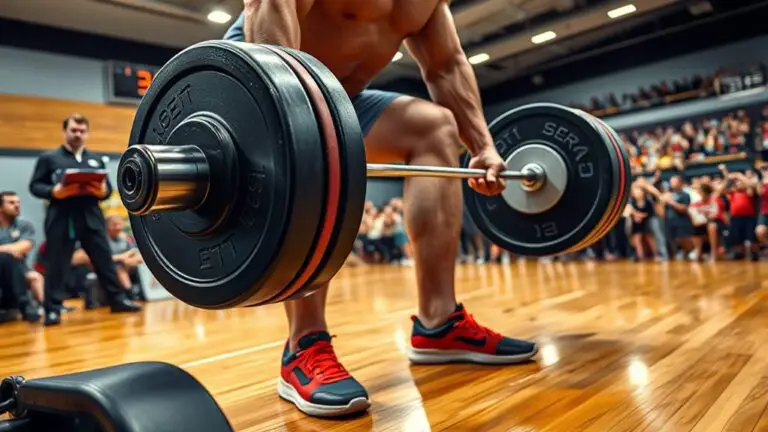The Best Gym Training Strategies for Advanced Lifters

To maximize your results as an advanced lifter, focus on structured periodization and implement advanced techniques like supersets and drop sets. Recovery is vital—prioritize quality sleep and nutrition timing to support muscle repair. Stay hydrated and maintain a balanced diet to fuel your workouts effectively. Don’t overlook the mental side; having clear goals and tracking your progress is key to staying motivated. Keep these strategies in mind, and you’ll discover even more ways to elevate your training.
Periodization: Structuring Your Training for Maximum Results

When you’re pushing your limits in the gym, understanding periodization can be the game-changer you need for achieving your goals. By implementing linear periodization, you can gradually increase intensity over time, helping you build strength efficiently. Alternatively, undulating periodization offers varied intensity and volume, keeping your muscles guessing and preventing plateaus. If you prefer targeted progress, block periodization focuses on specific goals within defined phases.
Incorporating concurrent training can enhance overall fitness, allowing you to develop strength and endurance simultaneously. Effective microcycle planning guarantees daily workouts align with your mesocycle goals, optimizing your progress. Don’t overlook the importance of tapering strategies, which help you peak at the right time. Finally, including deload weeks in your program is essential for recovery, preventing burnout and injuries. By structuring your training thoughtfully, you’ll maximize results and reach your lifting potential.
Advanced Lifting Techniques: Beyond the Basics
As an advanced lifter, mastering progressive overload methods and understanding periodization strategies can elevate your training to new heights. You’re not just lifting; you’re strategically planning your progress to maximize gains and minimize plateaus. Let’s explore how these techniques can transform your workouts and help you achieve your goals.
Progressive Overload Methods
While many lifters focus on increasing weights to achieve gains, mastering progressive overload involves a variety of innovative methods that can elevate your training to the next level. You can explore overload variations like changing rep ranges, adjusting tempo, or incorporating pause reps to stimulate muscle growth. These techniques not only prevent plateaus but also challenge your muscles in new ways. Additionally, intensity techniques, such as drop sets or rest-pause sets, can push your limits further, enhancing strength and endurance. By incorporating these methods, you’ll keep your workouts fresh and engaging. Remember, it’s not just about lifting heavier; it’s about lifting smarter. Embrace these strategies, and watch your performance soar as you become a more advanced lifter.
Periodization Strategies Explained
To maximize your gains and keep your body adapting, understanding periodization strategies is essential for advanced lifters. Here are three effective approaches you should consider:
- Linear Progression: This method focuses on gradually increasing the weights you lift over time, typically weekly, providing a straightforward path to strength gains.
- Undulating Periodization: This strategy alternates the intensity and volume of your workouts throughout the week, allowing for varied stimulus and preventing plateaus.
- Block Periodization: This involves breaking your training into distinct blocks, each targeting specific goals, such as hypertrophy or strength, ensuring thorough development.
The Importance of Recovery: Strategies for Optimal Muscle Repair

Recovery is just as essential as your training regimen, and optimizing it can lead to significant gains. By focusing on sleep quality and nutrition timing, you can enhance muscle repair and performance. Don’t underestimate the power of recovery; it’s where the real progress happens.
Sleep Quality Enhancement
Since your muscles undergo considerable stress during intense training, prioritizing sleep quality is essential for ideal repair and growth. To enhance your sleep, consider these strategies:
- Optimize Your Sleep Environment: Keep your bedroom dark, cool, and quiet to promote deep sleep. Invest in comfortable bedding for optimal comfort.
- Establish Sleep Routines: Go to bed and wake up at the same time daily. This consistency helps regulate your body’s internal clock.
- Incorporate Relaxation Methods: Utilize techniques like meditation or gentle stretching before bed. These recovery techniques can calm your mind and prepare your body for sleep.
Additionally, explore sleep supplements and utilize sleep tracking to monitor your progress. Prioritizing these elements will greatly improve your recovery and performance.
Nutrition Timing Optimization
While you might focus on lifting heavy weights and pushing your limits in the gym, the timing of your nutrition plays a critical role in maximizing muscle repair and growth. Proper meal timing can enhance recovery, especially when you consume key nutrients around your workouts. Aim to eat a balanced meal with the right nutrient ratios—carbohydrates, proteins, and fats—before and after your training sessions. This not only fuels your workout but also kickstarts muscle recovery. Consuming protein within 30 minutes post-exercise can considerably aid in muscle repair. Additionally, timing your carbohydrate intake can help replenish glycogen stores, ensuring you’re ready for your next session. Prioritize your nutrition timing to access your full potential and achieve lasting gains.
Nutrition for Performance: Fueling Your Workouts
To maximize your performance in the gym, understanding how to properly fuel your body is vital. Here are three key strategies to elevate your training:
Properly fueling your body is essential for maximizing gym performance and elevating your training.
- Meal Prep & Macro Balance: Planning your meals in advance guarantees you’re getting the right balance of macros—proteins, carbs, and fats. This is critical for energy and recovery.
- Hydration Strategies: Staying hydrated can’t be overlooked. Proper hydration affects muscle function and endurance. Aim for consistent water intake throughout the day, especially before and after workouts.
- Nutrient Timing: Pay attention to food timing. Incorporate pre-workout snacks rich in carbs and protein for energy, and focus on post-workout recovery meals with anti-inflammatory foods to help reduce soreness.
Mental Strategies: The Mindset of an Advanced Lifter

As you advance in your lifting journey, honing your mental strategies becomes just as essential as your physical training. One powerful technique is goal visualization. Picture yourself achieving your targets—whether it’s lifting a specific weight or completing a challenging workout. This mental imagery not only boosts your confidence but also helps you stay focused during tough sessions.
Incorporating positive reinforcement is another key strategy. Celebrate your small victories, whether it’s hitting a personal record or perfecting your form. Acknowledging these achievements reinforces your commitment and encourages you to push through barriers.
Tracking Progress: Metrics and Tools for Continuous Improvement
Tracking your progress is essential for any advanced lifter aiming for continuous improvement. By keeping an eye on your performance metrics, you can identify what works best for you and make informed adjustments. Here are three effective strategies for progress tracking:
Tracking your progress is vital for advanced lifters, helping you make informed adjustments for continuous improvement.
- Workout Logs: Maintain a detailed log of your workouts, including exercises, weights, sets, and reps. This provides you with a clear history of your performance.
- Body Measurements: Regularly measure key areas like your waist, chest, and arms. These metrics help you see physical changes that may not be apparent in the mirror.
- Strength Testing: Periodically test your one-rep max for key lifts. This not only shows strength gains but also helps in setting new goals.
Using these methods, you’ll stay accountable and motivated, ensuring that your training remains effective and aligned with your objectives.
Frequently Asked Questions
How Often Should I Change My Workout Routine?
You should change your workout routine every 4 to 8 weeks to keep your progress on track. This helps prevent plateaus and keeps your workouts engaging. Incorporating progressive overload is essential, so as you adapt, increase the weights or intensity. Also, consider your training frequency; if you’re hitting the gym multiple times a week, mixing up your routine can enhance results. It’s all about finding the right balance for your goals!
What Are the Best Warm-Up Exercises for Advanced Lifters?
Imagine stepping into the gym, your muscles ready to awaken. For advanced lifters, the best warm-up exercises include dynamic stretching and mobility drills. Picture yourself moving through leg swings, arm circles, and hip openers, each motion igniting your body’s potential. These warm-ups not only enhance flexibility but also prepare your joints for heavy lifts. So, don’t skip them; they’re essential for maximizing performance and preventing injuries, ensuring your workout starts on the right foot.
Should I Focus More on Strength or Hypertrophy Training?
When deciding between strength vs. hypertrophy, consider your training goals. If you’re aiming for maximal strength, focus on lower reps with heavier weights. On the other hand, if you’re looking to increase muscle size, higher reps with moderate weights will be more effective. It’s essential to balance both aspects to avoid plateaus. Ultimately, tailor your routine to what you want to achieve, ensuring you stay motivated and see the results you desire.
How Can I Prevent Plateaus in My Training?
To prevent plateaus in your training, you need to embrace progressive overload and incorporate training variety. Gradually increase your weights, reps, or intensity to challenge your muscles consistently. Additionally, change up your exercises, rep ranges, or training splits to keep your body guessing. Don’t forget to listen to your body and allow for adequate recovery. By mixing things up and pushing your limits, you’ll keep making gains and avoid stagnation.
What Role Does Sleep Play in My Training Outcomes?
Sleep’s significance in shaping your training outcomes can’t be overstated. Prioritizing sleep recovery and enhancing sleep quality can propel your performance and progress. When you snooze, your body repairs, rebuilds, and replenishes, ensuring you’re ready to tackle tough workouts. Without adequate rest, you risk fatigue and frustration, leading to diminished gains. So, don’t underestimate the power of peaceful slumber—it’s a key component in achieving athletic excellence and avoiding setbacks in your training journey.





